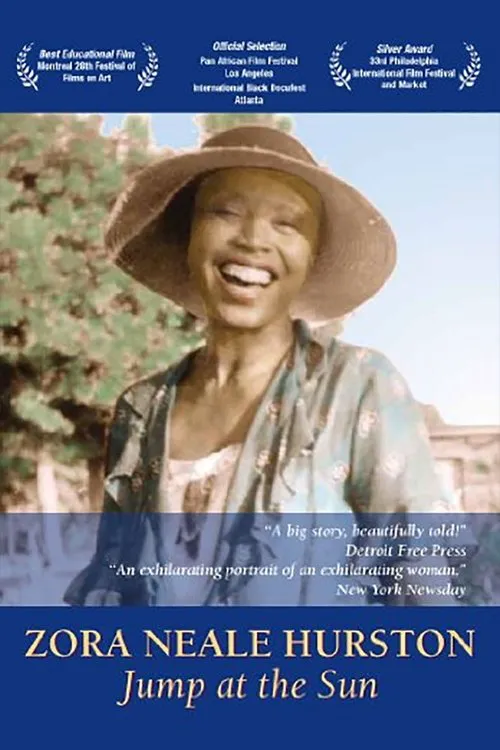Zora Neale Hurston: Jump at the Sun

Plot
Zora Neale Hurston: Jump at the Sun chronicles the extraordinary life and times of Zora Neale Hurston, a pioneering novelist, anthropologist, and essayist who boldly defied conventions to etch her name in the American literary canon. Born on January 7, 1891, in Notasulga, Alabama, Hurston's early life was marked by a fierce determination to pursue her dreams, despite facing numerous obstacles and biases as a black woman in a racist society. Growing up in Eatonville, Florida, a small African American town founded by freed slaves, Hurston developed a profound appreciation for her cultural heritage and the rich, vibrant oral traditions of her community. She drew inspiration from the stories, songs, and proverbs of her elders, which would later become the foundation of her distinctive writing style. Hurston's experiences in Eatonville instilled in her a deep sense of pride and self-awareness, shaping her perspective on the world and informing her creative vision. As a young woman, Hurston pursued higher education at Howard University, where she studied under celebrated writer and educator Alain Locke. Locke, known for his influential essay "The New Negro," played a pivotal role in shaping Hurston's literary ambitions and introducing her to the likes of W.E.B. Du Bois, a prominent intellectual and civil rights leader. Du Bois, who became a close friend and mentor, encouraged Hurston to explore the rich cultural heritage of African Americans, fostering her interest in anthropology. Hurston's intellectual curiosity and passion for learning led her to continue her education at Barnard College in New York City, where she earned a scholarship and immersed herself in the city's vibrant cultural scene. It was during these formative years that Hurston became part of a circle of influential writers, artists, and intellectuals, including Langston Hughes, Countee Cullen, and Aaron Douglas, who collectively sought to redefine the African American experience through their work. Upon graduating from Barnard, Hurston traveled to Haiti on a research expedition, sponsored by Franz Boas, a renowned anthropologist at Columbia University. Boas, who was instrumental in shaping Hurston's academic pursuits, recognized her unique talent for storytelling and encouraged her to apply anthropological theories to her writing. In Haiti, Hurston immersed herself in the local culture, learning Vodou rituals, Creole language, and the oral traditions of the island's people. This fieldwork experience profoundly influenced her writing, shaping the narrative voice and cultural context of her future works. Upon returning to the United States, Hurston wrote her magnum opus, Their Eyes Were Watching God, a novel that defied conventions and shattered stereotypes of black life. Published in 1937, the book tells the story of Janie Crawford, a strong-willed African American woman, as she navigates love, identity, and societal expectations. The novel's groundbreaking narrative voice, infused with African American slang and folk wisdom, gave voice to the experiences of black women in a way that resonated with readers from diverse backgrounds. Throughout her life, Hurston navigated complex relationships, both personal and professional. Her association with the prominent writer and activist, Langston Hughes, was the subject of much speculation and debate. While the two artists maintained a close professional relationship, some accounts suggest a romantic connection. This ambiguous dynamic mirrors the nuanced and multilayered aspects of Hurston's personality, which this film biopic masterfully depicts. The film also delves into Hurston's later years, marked by personal struggle and professional decline. After the publication of Her Eyes Were Watching God, Hurston continued to write, producing several notable works, including Seraph on the Suwanee (1948). However, her later years were marred by financial struggles, which led her to rely on friends and patrons, including Marjorie Kinnan Rawlings, the Pulitzer Prize-winning author of Cross Creek. Hurston spent her final years in relative obscurity, a consequence of the racist attitudes that had long plagued her career. When she passed away on January 28, 1960, Hurston was largely unknown, a stark contrast to her significant contributions to American literature. It would take decades for scholars, critics, and readers to rediscover the work of this groundbreaking writer, a revival sparked by feminist scholars, who sought to acknowledge the contributions of women writers to the literary canon. Through Zora Neale Hurston: Jump at the Sun, filmmaker Haile Gerima masterfully brings to life the multifaceted figure of this pioneering writer. By tracing Hurston's intellectual and creative journey, the film reveals the complexities and nuances of her personality, defying reductive categorizations and myths that have often surrounded her public image. As a celebration of Hurston's life and work, this film provides a rich, compelling portrait of an artist who refused to conform to societal expectations, instead forging her own path, one that continues to inspire and empower readers today.
Reviews
Recommendations


